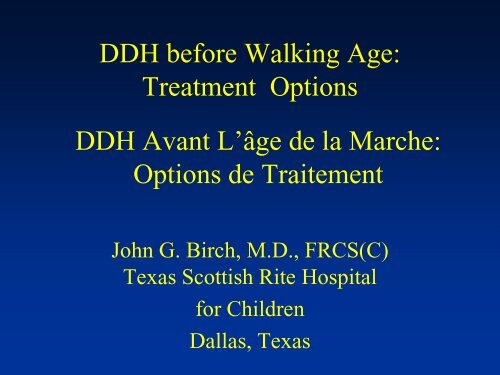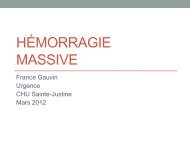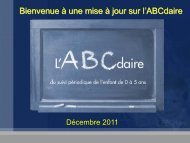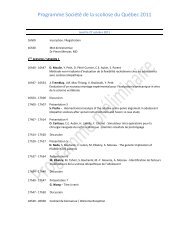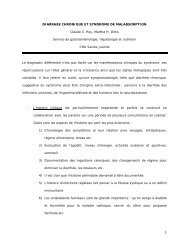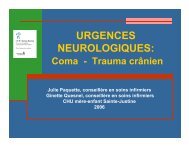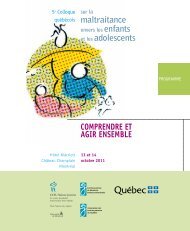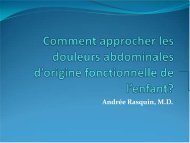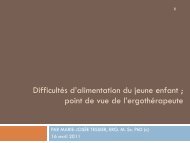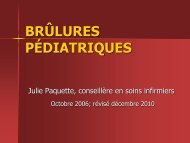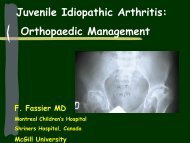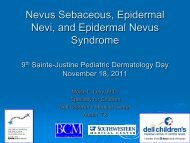DDH before Walking Age - CHU Sainte-Justine - SAAC
DDH before Walking Age - CHU Sainte-Justine - SAAC
DDH before Walking Age - CHU Sainte-Justine - SAAC
- No tags were found...
You also want an ePaper? Increase the reach of your titles
YUMPU automatically turns print PDFs into web optimized ePapers that Google loves.
<strong>DDH</strong> <strong>before</strong> <strong>Walking</strong> <strong>Age</strong>:Treatment Options<strong>DDH</strong> Avant L’âge de la Marche:Options de TraitementJohn G. Birch, M.D., FRCS(C)Texas Scottish Rite Hospitalfor ChildrenDallas, Texas
Hip Dislocations• Remember that thereare differentialdiagnoses to beconsidered:– Traumatic– Septic– Paralytic– Congenital(Developmental)
Classification of DevepmentalDysplasia of the Hip (<strong>DDH</strong>)• Typical• Teratologic
Teratologic Dislocations• Out in utero• Major changes inmuscle, femoral head,acetabulum from birth• Associated with spinabifida, arthrogryposis,other conditions• Treatment is surgical(when indicated)Factors: age, severity, bilaterality
Typical Dislocations• Near normal in utero• Minor changes atbirth(Ponseti)
• Femoral head,acetabulum becomemisshapen and anteverted• Ligamentum tereshypertrophies• Inferior hip capsuleconstricts underbowstrung psoas tendon(hourglass constriction)• All muscle groups tightendue to telescoping effectof dislocationPathology
Incidence• 1:80 hips unstable atbirth• 1:1000 remain treatable<strong>DDH</strong>– (i.e., majoritystabilize in the first 6weeks of life)
The first requirement of treatment of<strong>DDH</strong> is to make the diagnosis:-Physical Examination-Vigilance Program
The second requirement of treatment of<strong>DDH</strong> is to understand the pathology andseverity of disease:Dislocatable < Ortolani +ve < Ortolani -ve
• Reduced in the restingposition• Dislocatable with theBarlow maneuver• May stabilizespontaneously or withtreatment• May convert to dislocatedwithout treatmentDislocatable Hip
Dislocated Hip• Dislocated in the restingposition• May reduce with theOrtolani maneuver; thiswill be lost• Will not resolve withouttreatment
Physical Findings• Dislocated:– Asymmetric thighfolds– Limited abduction– Positive Galeazzi– Pistoning– Trendelenburg gait
High Resolution Ultrasonography
High Resolution Ultrasonography• Keys to orientation:– femoral head– metaphyseal edge– angle of the ilium– triradiate cartilage– labrum
Alpha and Beta Angles• Alpha angle:– angle between the ilialline and the acetabularroof– normally is >60°• Beta angle:– between ilial line andlabrum– normally
High Resolution Ultrasonography
High Resolution Ultrasonography
The Problem of Screening andLate DislocationsJournal of Bone and Joint Surgery 71-B, 1989
The Problem of Screening andLate Dislocations<strong>DDH</strong>Journal of Bone and Joint Surgery 71-B, 1989
Treatment• 0-6 months: Pavlik harness-Dislocatable->Dislocated-Hips flexed beyond 90°
• Technique:Pavlik Harness– Keep hip flexed 100-120° flexed, slightlyabducted– Document hipreduction by 4 weeks;if not reduced by thattime, abandon harness– Hold until stabilized
Treatment• Our Pavlik harnessprotocol:– 23-hour wear– Weekly/bi-weeklyexaminations (physicaland ultrasound)– Observe for evidence offemoral nerve palsy
Pavlik Harness Treatment Complications• Lack of compliance– ?Incidence• Failure to achievereduction/stablization– 0% dislocatable– 25% Ortolani +ve– 50% (or more) fixeddislocations
Pavlik Harness Treatment Complications• Femoral nerve palsy• Osteonecrosis– 0 to 15 %• “Pavlik disease”– Worsening acetabulardysplasia withoutreduction of femoralhead
Femoral Nerve Palsy• TSRH Experience:– Manifested by inability to extend knee actively– Incidence 2.5% (all resolved afterdiscontinuation of harness)– Always <strong>DDH</strong>-affected side– Incidence related to severity of dislocation, sizeand age of infant– Failure to resolve within 3 days (withreapplication of Pavlik harness) meansoperative reduction much more likely(Murnaghan et al, JBJS 93:493, 2011)
Avascular Necrosis• Very rare (probably
Fixed Abduction OrthosesTwo indications:-Treatment of residualdysplasia (efficacy notproven, and controversial).-As alternative to Pavlikharness for unstable(dislocatable and dislocated,reducible) hips notresponding to Pavlik(Hedequist et al., JPO 23:175, 2003)
Treatment• 6-12 months (or after Pavlikharness failure):– Traction (Bryant’s or otherbalanced skin traction)(controversial)– Closed reduction +/-adductor tenotomy, +/-arthrogram (controversial)– Double hip spica cast for 3-4 1/2 months– Abduction night splint untilnormal (controversial)Open reduction if closed reduction fails
Safe Zone• Zone from maximumabduction to point wherehip redislocates• Wider the “safe zone”, themore stable the reduction• Hold in middle of safe zone(ideally 45-60° ofabduction)• Do not immobilize in >60°abduction
ArthrogramI like to do arthrograms at the time of closedreduction and spica changes as an adjunct to myphysical examination (controversial).
Spica Application• Always under generalanesthetic/sedation• Hip hyperflexed,abducted• Neutral rotation• Avoid: abduction >60°,Lorenz position(extended, internallyrotated)
No-No’s
No-No’s“Your killing my ossific nucleus!!”
Closed Reduction• Post reduction CT scan– Triradiate baseline
MRI likely to be most valuable adjunct onceacquisition speed and cost issues resolved
And if Closed Reduction Fails:• Medial or AnteriorOpen Reduction• Remove all impediments toreduction– Psoas and capsule– Transverse acetabularligament– Pulvinar– Ligamentum teres– Inverted labrum
Medial Open Reduction• Minimal blood loss• Direct exposure of psoas/hourglass• Bilateral at one setting• Increased AVN?
Anterior Open Reduction• Salter incision best• Smith-Peterson approach• Release iliopsoas• Open capsule with asuperior “T” for latercapsulorrhaphy• Get medial and inferiorenough• More dissection / blood loss• Stage bilateral
We are alwaysprepared to performfemoral shorteningas adjunct toanterior (andmedial) openreduction, ifreduction is “tight”due to associatedmuscle contracturesFemoral Shortening
Avascular Necrosis• Cause: Treatment– Forcible reduction– Reduction withouttraction– Open reduction• Effect:– Small, deformed head– Trochanter overgrowth– Leg length discrepancy
AVN – Classification• Bucholz – Ogden
Summary• Make the diagnosis– Vigilant physical examination+/- ultrasound• Quantify severity of dysplasia(for prognostic purposes)• < 6 months: Pavlik harness• > 6 months (or harness failure):– Attempt closed reduction– Open reduction (medial oranterior) if CR fails
Thanks!Merçi!


